Zengqiang Shang
Emilia: A Large-Scale, Extensive, Multilingual, and Diverse Dataset for Speech Generation
Jan 27, 2025Abstract:Recent advancements in speech generation have been driven by the large-scale training datasets. However, current models fall short of capturing the spontaneity and variability inherent in real-world human speech, due to their reliance on audiobook datasets limited to formal read-aloud speech styles. To bridge this gap, we introduce Emilia-Pipe, an open-source preprocessing pipeline to extract high-quality training data from valuable yet underexplored in-the-wild data that capture spontaneous human speech in real-world contexts. By leveraging Emilia-Pipe, we construct Emilia, the first multilingual speech generation dataset derived from in-the-wild speech data. This dataset comprises over 101k hours of speech across six languages: English, Chinese, German, French, Japanese, and Korean. Besides, we expand Emilia to Emilia-Large, a dataset exceeding 216k hours, making it the largest open-source speech generation dataset available. Extensive experiments demonstrate that Emilia significantly outperforms traditional audiobook datasets in generating spontaneous and human-like speech, showcasing superior performance in capturing diverse speaker timbre and speaking styles of real-world human speech. Furthermore, this work underscores the importance of scaling dataset size to advance speech generation research and validates the effectiveness of Emilia for both multilingual and crosslingual speech generation.
SF-Speech: Straightened Flow for Zero-Shot Voice Clone on Small-Scale Dataset
Oct 16, 2024



Abstract:Large-scale speech generation models have achieved impressive performance in the zero-shot voice clone tasks relying on large-scale datasets. However, exploring how to achieve zero-shot voice clone with small-scale datasets is also essential. This paper proposes SF-Speech, a novel state-of-the-art voice clone model based on ordinary differential equations and contextual learning. Unlike the previous works, SF-Speech employs a multi-stage generation strategy to obtain the coarse acoustic feature and utilizes this feature to straighten the curved reverse trajectories caused by training the ordinary differential equation model with flow matching. In addition, we find the difference between the local correlations of different types of acoustic features and demonstrate the potential role of 2D convolution in modeling mel-spectrogram features. After training with less than 1000 hours of speech, SF-Speech significantly outperforms those methods based on global speaker embedding or autoregressive large language models. In particular, SF-Speech also shows a significant advantage over VoiceBox, the best-performing ordinary differential equation model, in speech intelligibility (a relative decrease of 22.4\% on word error rate) and timbre similarity (a relative improvement of 5.6\% on cosine distance) at a similar scale of parameters, and even keep a slight advantage when the parameters of VoiceBox are tripled.
Emilia: An Extensive, Multilingual, and Diverse Speech Dataset for Large-Scale Speech Generation
Jul 07, 2024



Abstract:Recently, speech generation models have made significant progress by using large-scale training data. However, the research community struggle to produce highly spontaneous and human-like speech due to the lack of large-scale, diverse, and spontaneous speech data. This paper presents \textit{Emilia}, the first multilingual speech generation dataset from in-the-wild speech data, and Emilia-Pipe, the first open-source preprocessing pipeline designed to transform in-the-wild speech data into high-quality training data with annotations for speech generation. Emilia starts with over 101k hours of speech in six languages and features diverse speech with varied speaking styles. To facilitate the scale-up of Emilia, the open-source pipeline Emilia-Pipe can process one hour of raw speech data ready for model training in a few mins, which enables the research community to collaborate on large-scale speech generation research. Experimental results validate the effectiveness of Emilia. Demos are available at: https://emilia-dataset.github.io/Emilia-Demo-Page/.
Enhancing Spoofing Speech Detection Using Rhythm Information
Oct 18, 2023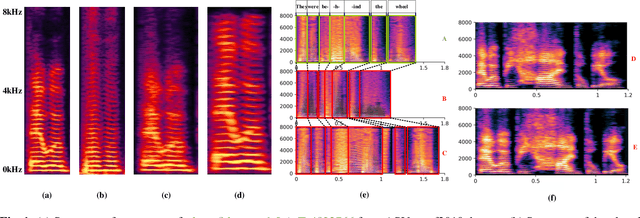

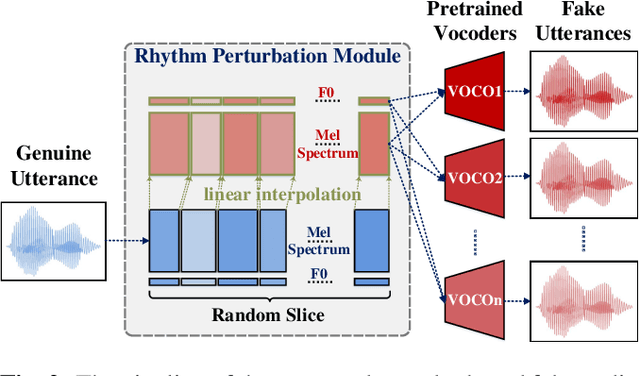

Abstract:Spoofing speech detection is a hot and in-demand research field. However, current spoofing speech detection systems is lack of convincing evidence. In this paper, to increase the reliability of detection systems, the flaws of rhythm information inherent in the TTS-generated speech are analyzed. TTS models take text as input and utilize acoustic models to predict rhythm information, which introduces artifacts in the rhythm information. By filtering out vocal tract response, the remaining glottal flow with rhythm information retains detection ability for TTS-generated speech. Based on these analyses, a rhythm perturbation module is proposed to enhance the copy-synthesis data augmentation method. Fake utterances generated by the proposed method force the detecting model to pay attention to the artifacts in rhythm information and effectively improve the ability to detect TTS-generated speech of the anti-spoofing countermeasures.
One-Class Knowledge Distillation for Spoofing Speech Detection
Sep 15, 2023Abstract:The detection of spoofing speech generated by unseen algorithms remains an unresolved challenge. One reason for the lack of generalization ability is traditional detecting systems follow the binary classification paradigm, which inherently assumes the possession of prior knowledge of spoofing speech. One-class methods attempt to learn the distribution of bonafide speech and are inherently suited to the task where spoofing speech exhibits significant differences. However, training a one-class system using only bonafide speech is challenging. In this paper, we introduce a teacher-student framework to provide guidance for the training of a one-class model. The proposed one-class knowledge distillation method outperforms other state-of-the-art methods on the ASVspoof 21DF dataset and InTheWild dataset, which demonstrates its superior generalization ability.
Improving Short Utterance Anti-Spoofing with AASIST2
Sep 15, 2023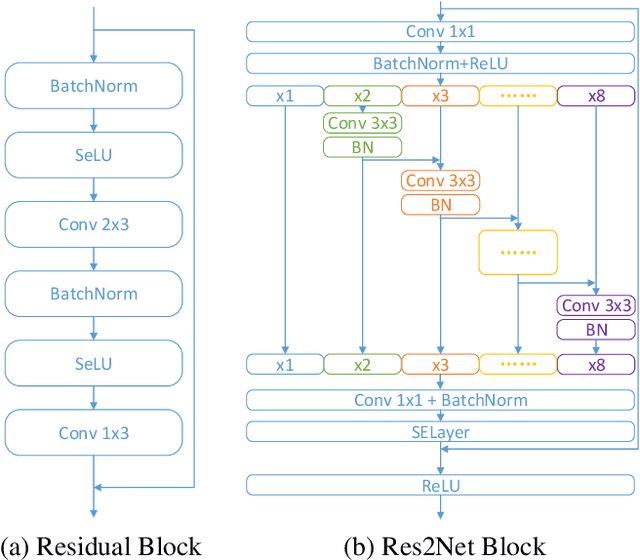

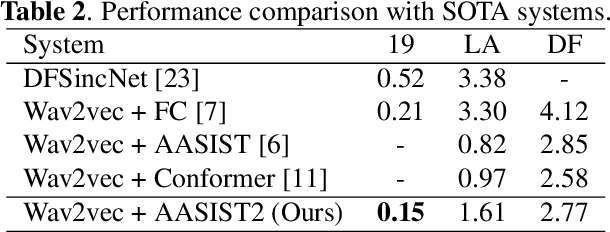
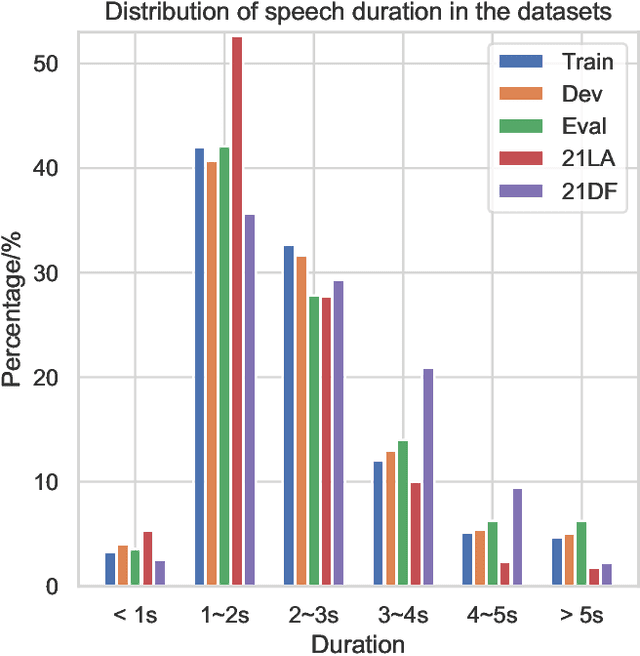
Abstract:The wav2vec 2.0 and integrated spectro-temporal graph attention network (AASIST) based countermeasure achieves great performance in speech anti-spoofing. However, current spoof speech detection systems have fixed training and evaluation durations, while the performance degrades significantly during short utterance evaluation. To solve this problem, AASIST can be improved to AASIST2 by modifying the residual blocks to Res2Net blocks. The modified Res2Net blocks can extract multi-scale features and improve the detection performance for speech of different durations, thus improving the short utterance evaluation performance. On the other hand, adaptive large margin fine-tuning (ALMFT) has achieved performance improvement in short utterance speaker verification. Therefore, we apply Dynamic Chunk Size (DCS) and ALMFT training strategies in speech anti-spoofing to further improve the performance of short utterance evaluation. Experiments demonstrate that the proposed AASIST2 improves the performance of short utterance evaluation while maintaining the performance of regular evaluation on different datasets.
Expressive paragraph text-to-speech synthesis with multi-step variational autoencoder
Sep 02, 2023



Abstract:Neural networks have been able to generate high-quality single-sentence speech with substantial expressiveness. However, it remains a challenge concerning paragraph-level speech synthesis due to the need for coherent acoustic features while delivering fluctuating speech styles. Meanwhile, training these models directly on over-length speech leads to a deterioration in the quality of synthesis speech. To address these problems, we propose a high-quality and expressive paragraph speech synthesis system with a multi-step variational autoencoder. Specifically, we employ multi-step latent variables to capture speech information at different grammatical levels before utilizing these features in parallel to generate speech waveform. We also propose a three-step training method to improve the decoupling ability. Our model was trained on a single-speaker French audiobook corpus released at Blizzard Challenge 2023. Experimental results underscore the significant superiority of our system over baseline models.
 Add to Chrome
Add to Chrome Add to Firefox
Add to Firefox Add to Edge
Add to Edge